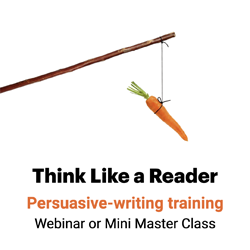What can readers do differently with your stuff?
What’s the difference between benefits and features?

Features
A feature is what it is:
Multitrack recording tools
Documentation repositories
Wearable technology webinars
When you get to the feature, you will have arrived at a noun — tools, repositories, webinars.
Unfortunately, nobody buys features — not in products, services, programs or ideas. So if you’re writing about features, nobody’s going to buy it, or read it.
Advantages
An advantage is what it does:
Creates clear audio
Holds thousands of resources
Makes wearable technology better
When you get to the advantage, you will have arrived at an adjective or adverb — a modifier — like clear, thousands, better.
Unfortunately, nobody buys advantages — not in products, services, programs or ideas. So if you’re writing about advantages, nobody’s going to buy it, or read it.
Benefits
An benefit is what you can do with it:
Get your message across
Create your webpage faster
Design wearable technology faster
When you get to the benefit, you will have arrived at a verb.
The good news is, everybody buys benefits — in products, services, programs or ideas. So if you’re writing about benefits, your readers are more likely to pay attention to, understand, remember and act on your message.
Features vs benefits
So how can you turn features into benefits? Show your prospective customers and clients how they can save time, make money, avoid effort or otherwise improve their lives with your product features.
After all, nobody wants a mobile phone. We want what we can do with a mobile phone.
Here’s how it works:
Before:
ABC is a multitrack recording tool.
Don’t write about your stuff. Write about what your readers can do with your stuff. Focus on the benefits of your products:
Get your message heard with professional audio from ABC.
Before:
Check out the new section in our documentation repository and start learning now!
This verb isn’t a benefit; it’s a task. Don’t tell readers to check out, register for, subscribe to, join you or attend. Tell them what they’ll be able to do differently if they check out, register for, subscribe to, join you or attend.
Create your webpage faster now with our documentation of the new process.
Before:
Designing wearable technology is a unique challenge for engineers of all disciplines. But there are many ways to make it easier.
It’s great to hit readers in their pain points. But the best marketing strategy goes further. What can they do differently with your “many ways”?
Learn to design wearable tech that customers want to buy with these seven tips.
Before:
XYZ, an ABC Community, is co-hosting a webinar with LMNOQ at 11 a.m. on Sept. 28 to give design engineers a brief overview of RF, explore RF applications, and go over the basics of ceramic capacitors, before taking a deep look into ceramic RF capacitors.
Don’t give your readers time, date, place before convincing them that they want to attend your event. Instead, answer the question in your reader’s mind: What’s in it for me? Why should I go?
Plus, the list of things you’re going to cover sounds like a threat, not a promise. What will I be able to do differently once I learn these things?
Design Engineers: Learn how you can save time and money using RF capacitors in your projects in this webinar.
Before:
Get FREE 24/7 on-demand, emotional support, and mental health coaching via text, through the Didi app. Sign up here!
Notice that pileup on modifiers — advantages — before the feature: FREE 24/7 on-demand. That’s a lot of words to describe your product. I’m not ready to sign up, because I don’t know what’s in it for me. Solution: Write in verbs about the reader.
Stressed? Anxious? Feeling down? Are your thoughts, emotions or behavior out of control? Get relief any time, night or day, for free via text with Didi, an emotional and mental health app.
Before:
Get our Small Business Growth Kit — with our 5-step guide and pitching template, growth stories from successful entrepreneurs, and best practices. You’ll also receive a personalized business assessment call from a sales coach to help you take your small business to new heights.
The kit, guide, template, stories, best practices and the call are features. What will I be able to do with this stuff?
Multiply your revenue and slash your expenses with our Small Business Growth Kit.
Before:
XYZ devices and solutions deliver industry-leading security to businesses of every size, while reducing IT burden across the organization.
Devices, solutions and security are features; industry-leading is an advantage. What can I do with this stuff?
Slash IT maintenance times, secure your intellectual property, and keep your private information private with XYZ security features.
Before:
Sign up for our annual event to learn how to streamline your sales & business processes.
Don’t lead with the task. Instead, lead with the benefit and follow up with the task:
Learn to close your sales deals twice as fast at ABC Live on 12 July in Geneva.
Before:
Success plans are a win-win for you and your customers.
Hmmmm … maybe. What does win-win mean? And don’t lead with your sales plans:
Predict risks before they occur, implement faster and reduce downtime with a success plan.
Before:
Multiple touch points are essential to the sales journey.
Maybe. What will multiple touch points do for me?
Close bigger deals faster by building solid relationships with multiple touch points.
Before:
With all the great features of update 3.0.12B, DataDeluxe makes it even easier to empower everyone in your organization with trusted data.
- And then what will happen? How will I benefit?
Make more profitable business decisions with more insightful data using DataDeluxe 3.0.12B’s new analytics capabilities.
Before:
This tool will drive your operational and revenue goals.
What can I do with it?
Grow your revenue faster and get the job done more efficiently with this new tool.
Features vs. benefits
It’s one of the best marketing strategies out there — Focus on the benefits, not the features:
- Don’t write about your products or services, write about the benefits of your products or services. Show how readers will save time, boost their bottom line, self-actualize, live healthier longer and otherwise improve their lives with your product features.
- Hit your prospective customers in their pain points. What problems can they solve using your products, services, programs or ideas? Remember, “negative benefits” often outperform positive ones. So Make ’em sick, make ’em well.
- Answer the question, What’s in it for me? After all, nobody wants a mobile phone; we want what the mobile phone can do for us. So stop writing about your tools, webinars, updates, plans, events, archives, tips, apps, kits, solutions and devices. And start writing about the reader and the reader’s needs.
- Write in verbs, not nouns or adjectives. Remember, features are nouns; advantages are adjectives; benefits are verbs. Focus on the verb.
- Lead with the benefit, substantiate with the feature. Don’t lead with you and your stuff; lead with the readers and what they can do with your stuff.

Leave a Reply